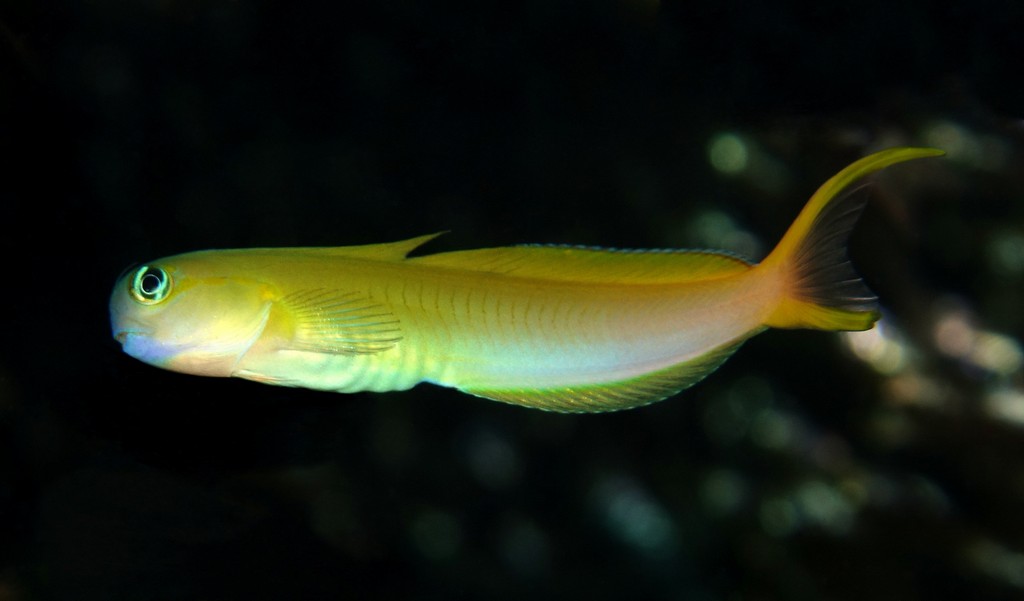ECSENIUS MIDAS - (STARCK, 1969)
Picture courtesy of: Alain Daoulas
Blennie de midas, Blennie perse, Lyre-tail comb-tooth, Lyre-tail combtooth-blenny, Lyretail blenny, Midas blenny, Midas combtooth blenny, Midas coralblenny, Golden blenny, Persian blenny, Goue blennie, Midas-slimfisk, Goldener Schleimfisch, Bavosa, Kaeru-uo, ハナダイギンポ, 金黃異齒鳚, ปลาตั๊กแตนหินแปลงสีส้ม,
Description
Épines dorsales (Total) : 12-14 (généralement : 13); Rayons mous dorsaux (Total) : 18-21 (généralement : 19 ou 20); Épines anales : 2; Rayons mous anaux : 20-23 (rarement : 20); Rayons nageoires pectorales : 12-14 (généralement : 13); Rayons nageoire caudale : 13-15 (généralement : 14). Poisson au corps allongé de couleur variable, jaune orangé ou brune à gris-bleu. L’individu peut rapidement changer de couleur mais est toujours reconnaissable aux deux barres bleues sur l’œil. Sa nageoire caudale est fourchue. Taille maximum : 13.0 cm TL. Profondeur : 2 - 40 m.
Etymologie
Ecsenius : origine incertaine, pourrait être dérivé du Grec, ekseio = arracher en secouant ou du Grec, exenios, -os, -on = incontrôlé, immodéré, effréné.
midas : le nom d'espèce vient de la légende grecque à propos de Midas. Midas, roi de Phrygie (VIIIe siècle av. J.-C.), héros de plusieurs légendes mythologiques, aurait régné de 715 à 676 av. J.-C. Pendant le Moyen Âge et surtout à la Renaissance, les alchimistes ont fait de la légende du roi Midas une allégorie de la dissolution de l'or alchimique.
Description originale : Ecsenius midas Starck, 1969 - Localité type : île d'Arros, archipel des îles Amirantes, Seychelles, Ouest de l'Ocean Indien, 85 pieds = 25/26 m.
Distribution
Mer Rouge, Pacifique Indo-Ouest : Est de l'Afrique, Seychelles, Ouest des Mascareignes, Maldives et archipel des Chagos, à l'Est, îles Marquises, au Nord, Sud du Japon, au Sud, Australie, Nouvelle-Calédonie et Tonga.
Biologie
Présent de la surface jusqu'à une trentaine de mètres de profondeur dans divers domaines récifaux. Elle trouve refuge dans des fourreaux désertés : de vers tubicoles, de mollusques vermiformes, de mollusques perforateurs, ou tout autre cavité creusée par d'autres organismes.
Il se nourrit surtout de zooplancton, mais également de phytoplancton. La ponte survient toujours à l'intérieur du tube, du repaire du mâle qui assure l'entretien, l'hygiène et la protection du couvain. Généralement craintives, elles se réfugient dans leur cavité en cas de menace.
Durant la phase jaune-orange elle est en compagnie de Pseudanthias squamipinnis (Peters, 1855). Il imite le comportement de nage d'autres poissons comme Pseudanthias huchtii (Bleeker, 1857) et Lepidozygus tapeinosoma (Bleeker, 1856).
Espèce ressemblante
Opistognathus aurifrons (Jordan & Thompson, 1905) - Présent dans l'Ouest de l'Atlantique.
-------------------------------------------
Description
Dorsal spines (total): 12-14 (usually: 13); Dorsal soft rays (total): 18-21 (usually: 19-20), the fin without a notch; Anal spines: 2; Anal soft rays: 20 - 23 (rarely: 20); Pectoral rays: 13; segmented caudal rays: 13-15 (usually: 14). Body relatively elongate, the depth about 5 in SL; Anterior profile of head convex, the snout overhanging mouth; Teeth incisiform, slender, fixed in jaws, and not numerous: 26-34 in upper jaw - 13-18 in lower jaw. Golden orange in color; Black spot around anus; anterior part of dorsal fin with narrow dark margin. Indonesian form grey or greenish to golden-yellow. Tail long in adults. Max length: 13.0 cm TL. Depth range: 2 - 40 m.
Etymology
Ecsenius: origine uncertain, from Greek, ekseio = shake out or off, or from Greek, exenios, -os, -on = uncontrolled, immoderate.
midas: the most famous King Midas is popularly remembered in Greek mythology for his ability to turn everything he touched with his hand into gold. This came to be called the Golden touch, or the Midas touch.
Original description: Ecsenius midas Starck, 1969 - Type locality: d'Arros Island, Amirante Islands, Seychelles, western Indian Ocean, depth 85 feet (25/26 m).
Distribution
Red Sea, Indo-West Pacific: East Africa, Seychelles, western Mascarenes, Maldives and Chagos Archipelago east to Marquesas Islands, north to southern Japan, south to northern Australia, New Caledonia and Tonga.
Biology
Adults inhabit coral reefs, from clear coastal to outer reef walls, usually where currents are moderate. They swim 2 to 3 m above the benthos, feeding on plankton. During the orange-yellow phase, they are observed to school with Pseudanthias squamipinnis (Peters, 1855) which they resemble in color. Individuals of Ecsenius midas can change color quickly from when on the bottom to swimming in open water to match the colors of the fishes they mix with. They also socially mimic their swimming behavior and also of Pseudanthias huchtii (Bleeker, 1857) and Lepidozygus tapeinosoma (Bleeker, 1856). Reported to feed on zooplankton. Oviparous. Eggs are demersal and adhesive, and are attached to the substrate via a filamentous, adhesive pad or pedestal. Larvae are planktonic, often found in shallow, coastal waters.
Similar species
Opistognathus aurifrons (Jordan & Thompson, 1905) - Reported from Western Atlantic.
